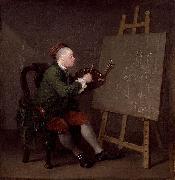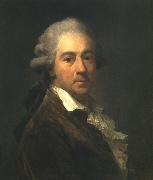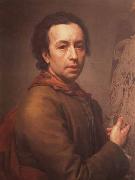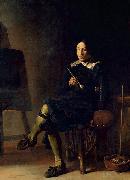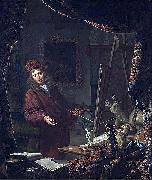
|
William Hogarth
|
|||
|
|
|||
| British 1697-1764 William Hogarth Galleries Early satirical works included an Emblematical Print on the South Sea Scheme (c.1721), about the disastrous stock market crash of 1720 known as the South Sea Bubble, in which many English people lost a great deal of money. In the bottom left corner, he shows Protestant, Catholic, and Jewish figures gambling, while in the middle there is a huge machine, like a merry-go-round, which people are boarding. At the top is a goat, written below which is "Who'l Ride" and this shows the stupidity of people in following the crowd in buying stock in The South Sea Company, which spent more time issuing stock than anything else. The people are scattered around the picture with a real sense of disorder, which represented the confusion. The progress of the well dressed people towards the ride in the middle shows how foolish some people could be, which is not entirely their own fault. Other early works include The Lottery (1724); The Mystery of Masonry brought to Light by the Gormogons (1724); A Just View of the British Stage (1724); some book illustrations; and the small print, Masquerades and Operas (1724). The latter is a satire on contemporary follies, such as the masquerades of the Swiss impresario John James Heidegger, the popular Italian opera singers, John Rich's pantomimes at Lincoln's Inn Fields, and the exaggerated popularity of Lord Burlington's prot??g??, the architect and painter William Kent. He continued that theme in 1727, with the Large Masquerade Ticket. In 1726 Hogarth prepared twelve large engravings for Samuel Butler's Hudibras. These he himself valued highly, and are among his best book illustrations. In the following years he turned his attention to the production of small "conversation pieces" (i.e., groups in oil of full-length portraits from 12 to 15 in. high). Among his efforts in oil between 1728 and 1732 were The Fountaine Family (c.1730), The Assembly at Wanstead House, The House of Commons examining Bambridge, and several pictures of the chief actors in John Gay's popular The Beggar's Opera. One of his masterpieces of this period is the depiction of an amateur performance of John Dryden's The Indian Emperor, or The Conquest of Mexico (1732?C1735) at the home of John Conduitt, master of the mint, in St George's Street, Hanover Square. Hogarth's other works in the 1730s include A Midnight Modern Conversation (1733), Southwark Fair (1733), The Sleeping Congregation (1736), Before and After (1736), Scholars at a Lecture (1736), The Company of Undertakers (Consultation of Quacks) (1736), The Distrest Poet (1736), The Four Times of the Day (1738), and Strolling Actresses Dressing in a Barn (1738). He may also have printed Burlington Gate (1731), evoked by Alexander Pope's Epistle to Lord Burlington, and defending Lord Chandos, who is therein satirized. This print gave great offence, and was suppressed (some modern authorities, however, no longer attribute this to Hogarth). | |||
|
|
|||
|
Self ortrait new24/William Hogarth-735698.jpg Painting ID:: 76468 |
Date ca. 1757(1757) Medium Oil on canvas Dimensions 45.1 ?? 42.5 cm (17.8 ?? 16.7 in) cyf | ||
|
|
|||
|
Marcello Bacciarelli
|
|||
|
|
|||
| 16 February 1731 - 5 January 1818) was an Italian painter of the late-baroque and Neoclassic periods. He studied in Rome under Marco Benefial. In 1750 he was called to Dresden, Saxony, where he was employed by Elected King Augustus III of Poland; after whose death he went to Vienna, and thence to Warsaw. There he met and worked by the side of Italian painter in Dresden, Vienna and Warszawa , Bernardo Bellotto. He was the Director there of the new set up Academy of Arts of Warsaw.He painted a set of the Polish kings, from Boleslaus Chrobry downwards. That of Stanislaus II, Stanisław August Poniatowski has been engraved by A. de Marcenay de Ghuy, Kestner, and A. Fogg. Bacciarelli also painted scenes from the History of Poland. He died at Warsaw. A number of his paintings were painted for King Stanisław August Poniatowski of Poland and are in the Royal Castle in Warsaw. | |||
|
|
|||
|
Self ortrait new24/Marcello Bacciarelli-457647.jpg Painting ID:: 81426 |
1793(1793) Medium Oil on canvas Dimensions 70.5 x 57.5 cm (27.8 x 22.6 in) cyf | ||
|
|
|||
|
Anton Raphael Mengs
|
|||
|
|
|||
| 1728-1779 Dutch Anton Raphael Mengs Gallery Mengs was born in 1728 at Usti nad Labem (German: Aussig) in Bohemia on 12 March 1728; he died in Rome 29 June 1779. His father, Ismael Mengs, a Danish painter, established himself finally at Dresden, whence in 1741 he took his son to Rome. In Rome, his fresco painting of Parnassus at Villa Albani gained him a reputation as a master painter. The appointment of Mengs in 1749 as first painter to Frederick Augustus, elector of Saxony did not prevent his spending much time in Rome, where he had married Margarita Quazzi who had sat for him as a model in 1748, and abjured the Protestant faith, and where he became in 1754 director of the Vatican school of painting, nor did this hinder him on two occasions from obeying the call of Charles III of Spain to Madrid. There Mengs produced some of his best work, and specially the ceiling of the banqueting-hall of the Royal Palace of Madrid, the subject of which was the Triumph of Trajan and the Temple of Glory. Among his pupils there was Agust??n Esteve. After the completion of this work in 1777, Mengs returned to Rome, and there he died, two years later, in poor circumstances, leaving twenty children, seven of whom were pensioned by the king of Spain. His portraits and autoportraits recall an attention to detail and insight, often lost from the grand manner paintings. Besides numerous paintings in the Madrid gallery, the Ascension and St Joseph at Dresden, Perseus and Andromeda at Saint Petersburg, and the ceiling of the Villa Albani must be mentioned among his chief works. In 1911, Henry George Percy, 7th Duke of Northumberland, possessed a Holy Family, and the colleges of All Souls and Magdalen, at Oxford, possessed altar-pieces by Mengs's hand. In his writings, in Spanish, Italian and German, Mengs has put forth his eclectic theory of art, which treats of perfection as attainable by a well-schemed combination of diverse excellences Greek design, with the expression of Raphael, the chiaroscuro of Correggio, and the colour of Titian. He would have fancied himself the first neoclassicist, while in fact he may be the last flicker of Baroque art. Or in the words of Wittkower, In the last analysis, he is as much an end as a beginning. His intimacy with Johann Joachim Winckelmann, who constantly wrote at his dictation, has enhanced his historical importance, for he formed no scholars, and the critic must now concur in Goethe's judgment of Mengs in Winckelmann und sein Jahrhundert; he must deplore that so much learning should have been allied to a total want of initiative and poverty of invention, and embodied with a strained and artificial mannerism. Mengs was famous for his rivalry with the contemporary Italian painter Pompeo Batoni. | |||
|
|
|||
|
Self ortrait new24/Anton Raphael Mengs-376365.jpg Painting ID:: 81437 |
1774(1774) Medium Oil on wood Dimensions 73.5 x 56.2 cm (28.9 x 22.1 in) cyf | ||
|
|
|||
|
Cornelis Saftleven
|
|||
|
|
|||
| (c. 1607, Gorinchem - 1 June 1681, Rotterdam) was a Dutch Golden Age painter He was born into a family of artists, and learned to paint from his father Herman, along with his brothers Abraham and Herman Saftleven the Younger. He lived for a time in Utrecht with his brother. Saftleven's subject matter covered various subjects, including genre works, portraits, beach scenes, and biblical and mythological themes. Some consider his images of Hell to be his most individual contribution to Dutch painting | |||
|
|
|||
|
Self ortrait new24/Cornelis Saftleven-956784.jpg Painting ID:: 81439 |
1629(1629) Medium Oil on panel Dimensions 31 x 23 cm (12.2 x 9.1 in) cyf | ||
|
|
|||
|
Musscher, Michiel van
|
|||
|
|
|||
| Dutch, 1645-1705 Dutch painter and printmaker. According to Houbraken, van Musscher received his eclectic artistic training in Amsterdam, studying first with the history painter Martinus Zaagmolen (c. 1620-69) in 1660, then with Abraham van den Tempel in 1661, followed by lessons with Gabriel Metsu in 1665. He completed his studies in 1667 in the studio of Adriaen van Ostade. The following year van Musscher returned briefly to Rotterdam before settling permanently in Amsterdam. | |||
|
|
|||
|
Self ortrait new24/Musscher, Michiel van-378766.jpg Painting ID:: 81455 |
1679(1679) Medium Oil on canvas Dimensions 57 x 46.5 cm (22.4 x 18.3 in) cyf | ||
|
|
|||
|
Also Buy::. For Following Paintings / Artists / Products, Please Use Our Search Online: |






